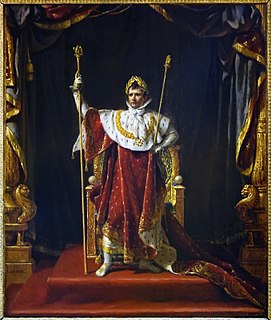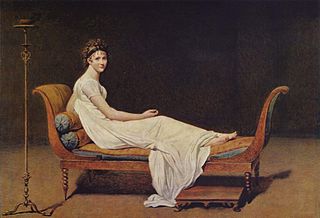 W
WThe Portrait of François Buron is a 1769 painting by Jacques-Louis David. It dates from his period of training and is one of his earliest known works. It shows his uncle, François Buron, and remained with his descendants until the death of his final descendant, A Baudry, in 1903. It was sold at the Regnault sale on 22 June 1905 for 6,000 francs. It then passed to Drouot at the Victor Gay sale on 23 April 1909 for 1,500 francs. It was sold anonymously on 15 December 1937 and later formed part of the collections of Robert Lebel and Madame Gas. It was sold to the Wildenstein galerie and then to its present private owner in New York City in 1985.
 W
WPortrait of Philippe-Laurent de Joubert is a painting by Jacques-Louis David. Its date is unknown, but Antoine Schnapper argues that it was between 1790 and 1792, since the subject died on 30 March 1792. It was left incomplete like his portraits of Madame Trudaine and Madame Pastoret. It is now in the Musée Fabre in Montpellier.
 W
WThe Portrait of Antoine-Laurent Lavoisier and his Wife is a double portrait of the French chemist Antoine Lavoisier and his wife and collaborator Marie-Anne Pierrette Paulze, commissioned from the French painter Jacques-Louis David in 1788 by Marie-Anne. It is now in the Metropolitan Museum of Art in New York.
 W
WPortrait of Alphonse Leroy is a 1783 portrait of doctor and man-midwife Alphonse Leroy by Jacques-Louis David, now in the Musée Fabre in Montpellier, which bought it in 1829.
 W
WPortrait of comte Antoine Français de Nantes is an 1811 oil on wood panel painting by Jacques-Louis David, showing Antoine Français de Nantes, prefect, comte d'Empire and grand officier of the Légion d’honneur.
 W
WThe Emperor Napoleon in His Study at the Tuileries is an 1812 painting by Jacques-Louis David. It shows French Emperor Napoleon I in uniform in his study at the Tuileries Palace. Despite the detail, it is unlikely that Napoleon posed for the portrait.
 W
WNapoleon in Imperial Costume was an 1805 portrait of Napoleon I in his coronation robes. Originally intended for the Tribuna in Genoa, Napoleon was unhappy with it and it was left incomplete. It is known via a small oil sketch now in the Palais des beaux-arts de Lille.
 W
WPortrait of Madame Pastoret is a 1791 portrait by Jacques-Louis David. It shows Adélaide Pastoret, née Piscatory de Vaufreland (1765-1843). He was a friend of the Pastoret family but broke with them in 1792 after he became more politically radical. With his portraits of Philippe-Laurent de Joubert and Madame Trudaine, it was one of three paintings left incomplete due to the advance of the French Revolution - all three figures were arrested or emigrated. An infant's head is also shown in the cot - this is Amédée de Pastoret, a future conseiller d'Etat, painted by Ingres in 1826.
 W
WThe Portrait of Pope Pius VII is an 1805 portrait of Pope Pius VII by the French painter Jacques-Louis David to thank the pope for assisting at the coronation of Napoleon I of France. Pope Pius appears in David's The Coronation of Napoleon, depicted as blessing the emperor, when in fact he was merely a spectator, assisting at the ceremony with a resigned expression throughout.
 W
WThe Portrait of Count Stanislas Potocki is a 1781 equestrian portrait of Polish patron, politician and writer Stanisław Kostka Potocki by the French painter Jacques-Louis David. It was painted in Rome when the artist and subject met during David's stay at the Villa Medici after winning the first prize for painting in the Prix de Rome, and chronologically after his Saint Roch interceding with the Virgin for the Plague-Stricken and before Belisarius begging for alms. Its equestrian format is owed to influences from Rubens.
 W
WPortrait of Madame Récamier is an 1800 portrait of the Parisian socialite Juliette Récamier by Jacques-Louis David showing her in the height of Neoclassical fashion, reclining on a Directoire style sofa in a simple Empire line dress with almost bare arms, and short hair "à la Titus."
 W
WThe Self-portrait is a self-portrait painted by the artist Jacques-Louis David in 1794 whilst in prison at the hôtel des fermes for having supported the robespierristes. It was his third and last self-portrait - the second was the 1791 Aux trois collets. He gave it to his former student Jean-Baptiste Isabey and it then entered the collections of the Louvre in 1852.
 W
WThe Portrait of Pierre Seriziat is a 1795 oil canvas portrait by French artist Jacques Louis David. The portrait shows an elegant and wealthy Frenchman, Pierre Seriziat, seated outdoors on top of a rock. The painting is one of a pair done by David for Seriziat and his wife Emilie. The companion piece, Portrait of Emilie Seriziat, shows a woman in a white dress indoors, holding flowers in one hand and the hand of a child in the other. Both paintings are held in the Louvre in Paris.
 W
WThe Portrait of Madame Marie-Louise Trudaine is an unfinished 1791–1792 portrait of Marie-Louise Trudaine by the French painter Jacques-Louis David. It was commissioned from David by her brothers-in-law, the Trudaine brothers who welcomed David, the poet André Chénier, and other major artists of the time to their Parisian salon at place des Vosges. It shows her seated on a simple chaise, with her hands crossed on her lap and wearing a sober dress, a blue waist-sash and a white collar. Her expression is worried and reinforced by the tormented background and her unkempt hair.
 W
WHenriette de Verninac (1780–1827) was the daughter of Charles-François Delacroix, minister of Foreign Affairs under the Directory, and wife of the diplomat Raymond de Verninac Saint-Maur. She is known as the subject of a portrait by Jacques-Louis David.